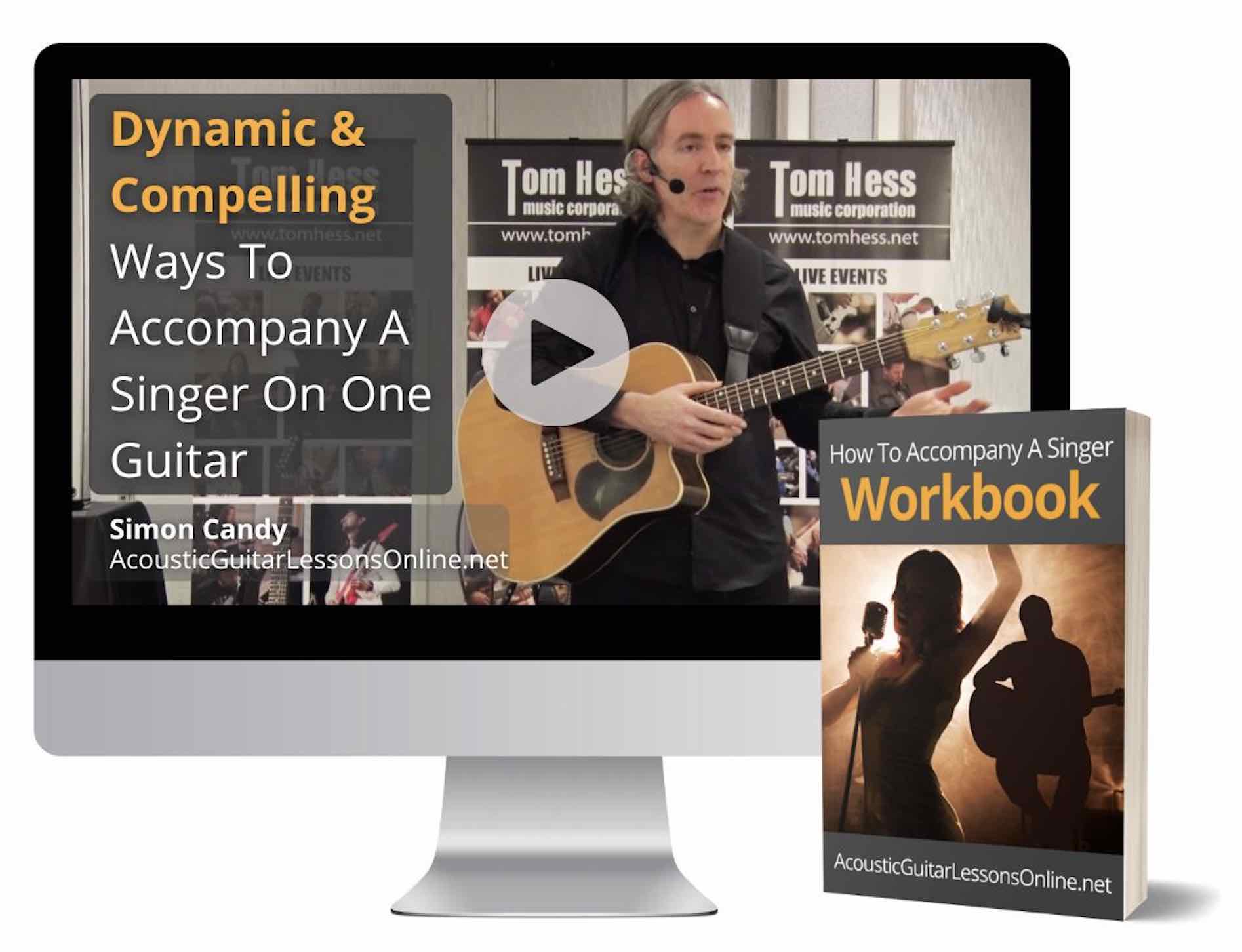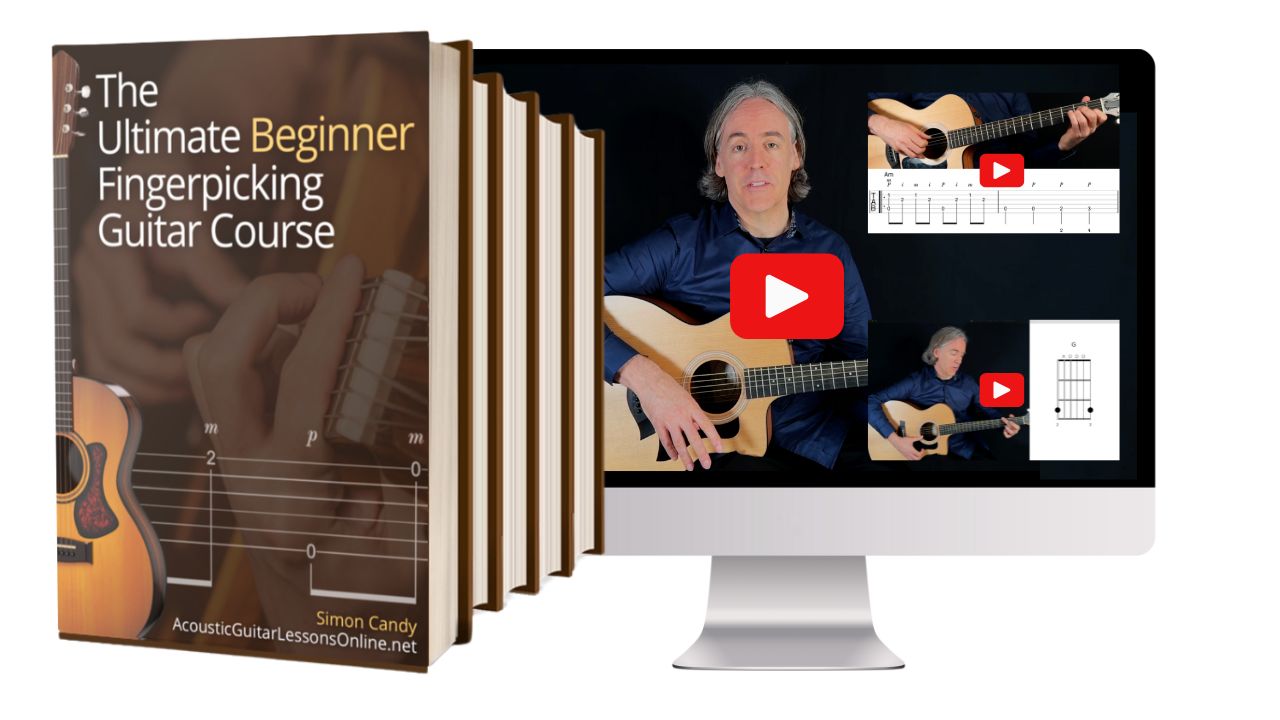Acoustic Guitar Lessons Online
Learn Acoustic Guitar The Right Way, Right Now And Save Yourself Years Of Wasted Time And Endless Frustration.
 So you want to learn how to play guitar, but you don't want it to take forever. You want to know how the great acoustic guitarists play (and create) such incredible music, but you don't want to be constantly frustrated every time you pick up your guitar to play. You are willing to put in the time & effort to learn guitar the right way, but only if you are not going to be wasting your time on boring exercises or practicing things that don't work.
So you want to learn how to play guitar, but you don't want it to take forever. You want to know how the great acoustic guitarists play (and create) such incredible music, but you don't want to be constantly frustrated every time you pick up your guitar to play. You are willing to put in the time & effort to learn guitar the right way, but only if you are not going to be wasting your time on boring exercises or practicing things that don't work.
You are smart enough to know that the easiest, fastest & best way to learn how to play and master the acoustic guitar is to learn from an experienced guitar teacher with a winning track record of teaching people like you to become excellent musicians, but you are also smart enough to know the difference between people who simply call themselves experts and someone who actually is one.
If I've correctly described what's been on your mind lately about learning to become an awesome acoustic guitar player, then you're in the right place.
Here's what you need to know about learning to play acoustic guitar the right way…
First, you need to know what's NOT true:
There are a lot of myths, fallacies and fairy tales out there about what it really takes to learn and become a great acoustic guitar player. For example:
- You should learn from as many different sources as possible.
- You should seek to always learn something new.
- You should master what you learn before moving on to something else.
- You should teach yourself in order to save money.
- You should take private in person acoustic guitar lessons to learn best.
- You can learn from any guitar teacher, they all teach the same basic things.
- You need to have natural talent in order to become a great guitar player.
- You need to practice hours and hours per day to learn how to play acoustic guitar well.
Here's the truth about these myths:
- Learning from as many different sources as possible: On the surface it may sound good to learn from many sources. However, in reality it's usually not. Why? Because your goal is not to simply acquire information, it is to become an excellent acoustic guitar player. To best do that, you need not only the tools but also a process to get there. When you take little bits and pieces from many different sources, you lack a proven process to achieve what you want to achieve. Therefore, it's far better to rely on one great source of information, lessons, training and process than to randomly collect information from lots of different sources.
- Always seek to learn something new: Believing in this myth can be dangerous to your development as a guitar player. Think about it, if all you needed to do in order to become a great acoustic guitar player was to learn something new each day, then all I would need to do to is create a book and sell it to you. We both know that mastering the guitar does not work that way. What does work is being taught what and how to do things and then give you the tools and the process to achieve your guitar mastery.
- Master what you learn before moving on to something else:Sometimes this is true, but other times this advice can really hurt your guitar playing progress. There are some things you should learn in a linear way and you need to master those things before moving onto the next step in a linear process. However, there are more things that absolutely should not be mastered before moving on to the next step. Why? Because a part of mastering the acoustic guitar is being able to take several things you are working on and tie them all together right now - even before you have mastered any of them. Yes, I realize this may sound counter-intuitive, but I can tell you as a world class guitarist and highly successful guitar teacher that this is a foundational core concept in learning and mastering the guitar (electric or acoustic).
- Teach yourself in order to save money: You need to ask yourself the following question, "Am I serious about learning how to play acoustic guitar or am I just screwing around here with this guitar?" If you're just screwing around, not serious at all and don't really care about ever playing guitar well, then sure you can do that all by yourself without investing anything into it. But you will become frustrated a lot and it will take a very long time to learn what and how to do things and in some cases you may never learn them even over a lifetime of trying…. Or you can get serious, save yourself years of frustration & slow progress and learn to finally become that guitarist you want to become.
- Take acoustic guitar lessons from a local teacher: Almost all local guitar teachers (in any part of the world) have absolutely zero education, training nor certification on how to teach guitar. Yes, you will find some that are experienced, but in experienced in what? Teaching things wrong year after year? That's not what you want to pay for. If typical local guitar teachers were so good, the average guitar student would be a lot better than they are. Most students do not develop into excellent players because their local teachers are commonly not excellent and trained teachers. It's that simple.
- You can learn from any guitar teacher, they all teach the same basic things: Not all guitar teachers are the same. There are many different methods (and lack of methods) out there. What the very best guitar teachers know that other teachers do not is that it's not just what you teach, but it's also about how you teach, the process of teaching and the specific order in which things are taught, learned and trained that makes the biggest impact on how fast (or slow) you will learn to play guitar well.
- You need to have natural talent in order to become a great guitar player: This is the biggest and most common myth of them all. No, you don't need to be born with special DNA to learn and master the guitar. Most of the great acoustic guitar players will be the first to tell you that they possessed no more natural talent than anyone else when they were learning to play acoustic guitar. Anyone can learn to play and to play at a very advanced level… anyone.
- You need to practice hours and hours per day to learn how to play acoustic guitar well: Yes, you need to practice your guitar. No, you absolutely do not need to spend a huge amount of time each day doing so. What you do need are the following things: the right person to guide you, an effective and efficient guitar practice routine and training on exactly how to practice.
 Hi, I'm Simon Candy. I've been teaching acoustic guitar for a very long time. I have the knowledge, training and expertise to transform the common person into an excellent guitar player. I'm dedicated, passionate and committed to doing the same for you. That's why I've created this website and all the lessons and tools for you to get started and complete your incredible, fulfilling and successful journey to becoming the awesome acoustic guitar player you want and will become.
Hi, I'm Simon Candy. I've been teaching acoustic guitar for a very long time. I have the knowledge, training and expertise to transform the common person into an excellent guitar player. I'm dedicated, passionate and committed to doing the same for you. That's why I've created this website and all the lessons and tools for you to get started and complete your incredible, fulfilling and successful journey to becoming the awesome acoustic guitar player you want and will become.
NEW COURSE: The Ultimate BEGINNER Fingerpicking Guitar Course
The Ultimate Beginner Fingerpicking Guitar Course is designed for you if:
• You’ve always wanted to fingerpick but never knew where to start
• You’ve tried fingerpicking but feel stuck, frustrated, or unsure of what to do next
• You want a step-by-step method to build the skills needed to fingerpick the music you love
Have you ever watched someone fingerpick and wondered how on earth they make it look so effortless?
Do you feel like fingerpicking is some mysterious skill reserved for the “naturally gifted,” while the rest of us just struggle along?
Here’s the truth: fingerpicking is not some magical talent. It’s a skill you can learn with the right guidance. And that’s exactly what this course gives you. You’ll get clear, step-by-step instructions from someone who knows how to get you results, even if you’re starting from zero.
No more guessing what to practice. No more YouTube rabbit holes. Just a clear path forward.
Imagine how rewarding it will be to finally experience the satisfaction of fingerpicking songs you love exactly the way you’ve always wanted. With every practice session, you feel the improvement you’re making, and your confidence begins to soar. The guitar, once a source of frustration, is now a trusted companion, one that provides you with endless hours of fulfilment, creativity, and joy.
All of this is very possible. Possible for YOU! It’s right at your fingertips!
Inside The Ultimate Beginner Fingerpicking Guitar Course, you’ll learn all the essential techniques in small, manageable steps—designed to build your skills without overwhelm. With every lesson, you’ll move closer to becoming the fingerstyle guitarist you’ve always wanted to be.
Finally, get over the “beginner hump” and watch your fingerpicking transform into a skill you can truly be proud of with The Ultimate Beginner Fingerpicking Guitar Course
The Ultimate Fingerpicking Guitar Course
The Ultimate Fingerpicking Guitar Course is designed for you if:
• You’ve been fingerpicking for a while, but feel like you’ve hit a plateau
• You can play a few patterns or songs, but don’t fully understand how to create your own fingerpicking arrangements
• You want to go beyond just copying what others play, and start truly understanding how fingerpicking works
Have you ever found yourself playing the same few patterns over and over, unsure how to move forward? Do you feel like there’s more to fingerpicking than just memorising songs, but you’re not sure how to unlock it?
Here’s the good news: there absolutely is more, and this course shows you how to tap into it.
You’ll go beyond the basics and start building real mastery of your fingerpicking technique, while also gaining a practical understanding of how chords and harmony work on the guitar.
No more relying on guesswork. No more being limited to what someone else has written out for you.
Instead, you’ll start learning how to apply your skills to real music and play with more creativity, confidence, and control. Your hands move with more control, your ideas come more easily, and the fretboard starts to make more sense. You’re arranging songs in your own style and sounding more like a true fingerstyle guitarist.
This course helps you get there.
You’ll refine your picking technique, deepen your understanding of chords and harmony, and learn how to apply it all in a practical, musical way so you can express yourself, not just copy what others play. Each lesson is clear, practical, and focused on helping you grow, not just as a player, but as a musician.
You already know you love fingerpicking. Now it’s time to deepen that skill and open the door to everything it can offer with The Ultimate Fingerpicking Guitar Course
Create Unplugged Acoustic Versions Of Songs On Guitar
 The Unplugged Acoustic Course is designed for you if:
The Unplugged Acoustic Course is designed for you if:
• You want to confidently create your own acoustic versions of songs that sound fresh, musical, and uniquely you
• You want to harness the rich, organic sound of the acoustic guitar and bring out all the warmth, texture, and character it offers
• You want to understand the why behind what you’re playing, so you can take the tools and techniques you learn and apply them creatively to your own music
Have you ever heard an acoustic version of a song that stopped you in your tracks that is raw, emotional, and even more powerful than the original?
There’s something magical about hearing a song stripped down to just a voice and an acoustic guitar. But when you’ve tried to do it yourself . . . it didn’t quite hit the mark, did it? That’s because simply copying chords and riffs from the original version doesn’t work. What sounds great on electric often falls flat when moved straight to acoustic. It takes more than a cut-and-paste approach to make a song come alive unplugged.
The good news? You can absolutely learn how to do it and this course shows you how.
You'll discover the techniques and creative approaches that bring energy, emotion, and personality to your acoustic arrangements.
This isn’t just about learning songs, it’s about learning how to reimagine them for the acoustic guitar in a way that sounds authentic, expressive, and uniquely yours.
And as you learn, you won’t just get better at arranging, you’ll become a stronger, more versatile guitarist in the process.
Learn how to create your own unplugged acoustic versions of songs on guitar
FREE eBook With Video: Quickstart Fingerpicking, 5 Simple Ways To Sound Great, Fast!
 BRAND NEW! Inside this eBook, you’ll discover a collection of simple, proven techniques and approaches tailored specifically for beginners, strategies that produce real, noticeable results almost immediately.
BRAND NEW! Inside this eBook, you’ll discover a collection of simple, proven techniques and approaches tailored specifically for beginners, strategies that produce real, noticeable results almost immediately.
Say goodbye to tedious exercises and dull drills. These fingerpicking shortcuts are designed to get you playing music that sounds rich, expressive, and surprisingly advanced right from the start, even if you’ve never fingerpicked before.
Whether you're picking up the technique for the first time or struggling to make progress, Quickstart Fingerpicking, 5 Simple Ways To Sound Great, Fast helps you sound like a seasoned player faster than you ever thought possible.
 Are you after more exciting and expressive ways to accompany yourself on guitar while singing or playing with another vocalist?
Are you after more exciting and expressive ways to accompany yourself on guitar while singing or playing with another vocalist?
Here is the scenario:
There is a vocal and a guitar, nothing more.
In a situation like this, open chords and strumming work to a certain point, but more is needed if we are to create something that sounds exciting, expressive, and dynamic.
What works when playing with a full band does NOT work when it is just you on your guitar, singing yourself or accompanying a vocalist. You need a whole different approach for situations like this.
In this free video workshop Dynamic And Compelling Ways For Arranging Music To Accompany A Singer On One Guitar you learn effective ways to create amazing sounding arrangements for a single guitar and vocal.
I have an actual singer on hand throughout the entire workshop, so everything concept covered is tried and tested in real time. Plus, there is a downloadable PDF workbook for you to follow along and create your own dynamic arrangements.
FREE eBook With Video: 10 Easy Melodic Fingerpicking Patterns You Can Learn In 10 Minutes Or Less
 Do you struggle to make the fingerpicking patterns you learn on guitar sound like music?
Do you struggle to make the fingerpicking patterns you learn on guitar sound like music?
I know how you feel. I would learn lots of fingerpicking patterns, but no matter how many I got down, they would all sound the same and anything like the music I wanted to hear.
I eventually discovered that learning patterns alone was not enough. It is what you do with the patterns that counts. In other words, how you APPLY them to create music.
In 10 Easy Melodic Fingerpicking Patterns You Can Learn In 10 Minutes Or Less, you learn 10 simple patterns with equally simple ways of applying them to create great sounding music! And the best thing?
No single pattern will take you longer than 10 minutes to learn.
Why Most People Quit Fingerpicking (And How To Avoid It)
BRAND NEW: Ever tried to bake a fancy soufflé before you’d even mastered scrambled eggs?
Yeah, doesn’t usually end well. Flat, collapsed, a bit tragic. And worst of all, you blame yourself.
That’s exactly what happens to most people learning fingerpicking guitar. They head to YouTube, type in “fingerpicking songs,” click a random video with a nice thumbnail and end up trying to learn Classical Gas on day one.
That’s like trying to run a marathon without ever learning to walk properly. No wonder people give up and think, “I guess I’m just not cut out for fingerpicking.”
But it’s not your fault.
If you start with the right songs, ones that are suitable for your level, you’ll actually make progress and feel a whole lot better about yourself. And most importantly, you’ll enjoy fingerpicking guitar!
In this video, you learn the top 7 mistakes to avoid when learning to fingerpick guitar.
Trying to learn songs beyond your current level of playing is one of them, but there are 6 more equally crucial mistakes to avoid that will only set you up for failure otherwise. If you’ve ever felt frustrated with fingerpicking, or you’re just getting started and want to avoid the common traps, don’t miss this video.
Watch below to learn more:
New to fingerpicking? Check out these online lessons for fingerstyle guitar
 When it comes to guitar playing, technique is a means to an end not an end in itself. It’s purpose is to serve your musical creativity.
When it comes to guitar playing, technique is a means to an end not an end in itself. It’s purpose is to serve your musical creativity.
How much technique you need depends on what you want to be able to do musically on your instrument.
When fingerpicking guitar, of course you need technique. However developing a whole lot of technique with little creative application is totally wasted technique, and a waste of your precious time.
Join me in this video masterclass and I will show you how to take simple fingerpicking techniques and convert them into music in very unique, innovative, and creative ways.
 In part 2 of this video masterclass, we are going to pick up where we left off learning more ways to convert an average sounding chord progression into great sounding music.
In part 2 of this video masterclass, we are going to pick up where we left off learning more ways to convert an average sounding chord progression into great sounding music.
Avoid becoming one of those players that spends large amounts of time building solid fingerpicking technique only to realise they have no way of applying it to create actual music.
Ok, maybe you can do some basic things that sound kind of ok, but what about the really cool stuff?
What about the kind of fingerpicking music you hear the greats play?
Join me in Part 2 of this video masterclass on creatively fingerpicking your guitar and I will continue to train you in applying simple fingerpicking skills and techniques to create beautiful and unique sounding music
Don't Miss The Latest Articles, Videos, & Resources About Playing Acoustic Guitar. Follow AcousticGuitarLessonsOnline.net on:


